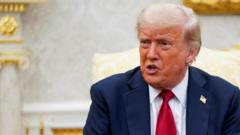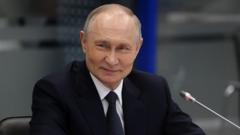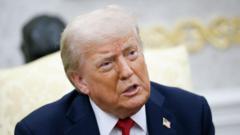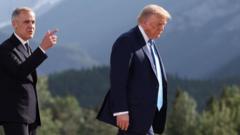China's GDP growth eased to 5.2% in the latter part of June, raising concerns about its annual growth target as trade tariffs and a struggling real estate sector weigh heavily on the economy.
China's Economic Growth Hits Soft Spot Amid Trade Tensions

China's Economic Growth Hits Soft Spot Amid Trade Tensions
China’s economy experiences a slowdown as trade conflicts and a property market crisis hinder its growth trajectory.
In recent months, China's economy has shown signs of weakening, primarily due to the escalating trade tensions exacerbated by tariffs imposed by the US and ongoing issues within the property market. Official statistics reveal that the world’s second-largest economy expanded by 5.2% in the second quarter, a slight decline from the 5.4% growth reported in the previous quarter.
Despite these challenges, China has managed to avoid a significant economic downturn largely thanks to supportive initiatives rolled out by the government and a tentative truce in the tariff battle with the United States. According to a statement from China’s National Bureau of Statistics, the economy "withstood pressure and made steady improvements." This resilience was largely fueled by a robust 6.4% rise in manufacturing output, buoyed by increased demand for advanced products such as 3D printers, electric vehicles, and industrial robots.
The services sector, which encompasses transportation, finance, and technology, has also shown promising results; however, retail sales growth noted a decrease, falling to 4.8% year-over-year in June, down from 6.4% in May.
Moreover, recent figures indicate a significant downturn in new home prices, dropping at the fastest rate in eight months, underscoring the persistent struggles of China's real estate sector despite multiple government efforts to stabilize property prices.
Economists are cautious about the possibility of China failing to meet its annual growth target of around 5%, with some suggesting that the economy could stabilize around a minimal growth threshold of 4%, considered politically acceptable. Dan Wang, a director at the Eurasia Group, emphasizes, "The real question is by how much."
The ongoing tariffs war between President Xi Jinping and the Trump administration marked a turning point in trade relations, leading to steep tariffs of 145% on Chinese imports from the US, while China retaliated with a 125% duty on certain American products. Although discussions in Geneva and London have led to a pause in these tariffs, both sides have a deadline of August 12 to negotiate a comprehensive trade agreement.
With these economic dynamics at play, the future trajectory of China's economy remains uncertain as it navigates external pressures and internal recovery efforts.
Despite these challenges, China has managed to avoid a significant economic downturn largely thanks to supportive initiatives rolled out by the government and a tentative truce in the tariff battle with the United States. According to a statement from China’s National Bureau of Statistics, the economy "withstood pressure and made steady improvements." This resilience was largely fueled by a robust 6.4% rise in manufacturing output, buoyed by increased demand for advanced products such as 3D printers, electric vehicles, and industrial robots.
The services sector, which encompasses transportation, finance, and technology, has also shown promising results; however, retail sales growth noted a decrease, falling to 4.8% year-over-year in June, down from 6.4% in May.
Moreover, recent figures indicate a significant downturn in new home prices, dropping at the fastest rate in eight months, underscoring the persistent struggles of China's real estate sector despite multiple government efforts to stabilize property prices.
Economists are cautious about the possibility of China failing to meet its annual growth target of around 5%, with some suggesting that the economy could stabilize around a minimal growth threshold of 4%, considered politically acceptable. Dan Wang, a director at the Eurasia Group, emphasizes, "The real question is by how much."
The ongoing tariffs war between President Xi Jinping and the Trump administration marked a turning point in trade relations, leading to steep tariffs of 145% on Chinese imports from the US, while China retaliated with a 125% duty on certain American products. Although discussions in Geneva and London have led to a pause in these tariffs, both sides have a deadline of August 12 to negotiate a comprehensive trade agreement.
With these economic dynamics at play, the future trajectory of China's economy remains uncertain as it navigates external pressures and internal recovery efforts.



















